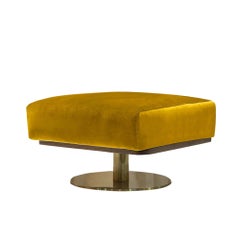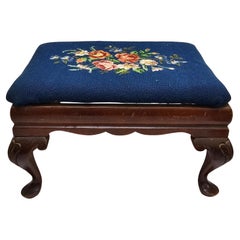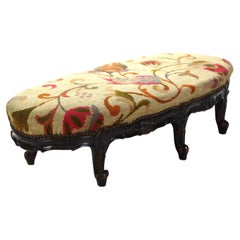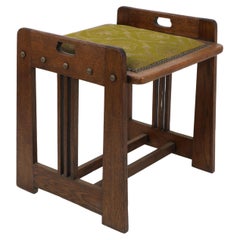Footstools
21st Century and Contemporary Portuguese Mid-Century Modern Footstools
Brass
Late 19th Century American Federal Antique Footstools
Mahogany, Upholstery
19th Century Louis XIV Antique Footstools
Tapestry, Walnut
2010s American Modern Footstools
Fur
Early 1900s Austrian Vienna Secession Antique Footstools
Oak, Cane, Fabric
Mid-20th Century American Mid-Century Modern Footstools
Wrought Iron
1980s Mid-Century Modern Vintage Footstools
Cotton
Early 20th Century Austrian Jugendstil Footstools
Bentwood
Mid-20th Century Footstools
Wrought Iron
2010s American Footstools
Oak, Upholstery
20th Century European Footstools
Walnut
1890s American Chinoiserie Antique Footstools
Giltwood
20th Century American Footstools
Cotton, Wood
1960s Mid-Century Modern Vintage Footstools
Wood
Mid-19th Century British Chinese Chippendale Antique Footstools
Upholstery, Wood
21st Century and Contemporary Lithuanian Scandinavian Modern Footstools
Sheepskin, Oak
21st Century and Contemporary American Minimalist Footstools
Wood
1960s Danish Scandinavian Modern Vintage Footstools
Leather, Teak
1970s French Directoire Vintage Footstools
Walnut
Late 20th Century Chinese Hollywood Regency Footstools
Iron
Late 20th Century Footstools
Cotton
21st Century and Contemporary Portuguese Mid-Century Modern Footstools
Silk, Velvet
1970s American Chinoiserie Vintage Footstools
Wood
1970s Unknown Directoire Vintage Footstools
Metal
Mid-20th Century English Footstools
Leather
21st Century and Contemporary Ukrainian Modern Footstools
Fabric, Plywood, Foam
19th Century Moroccan Primitive Antique Footstools
Brass
21st Century and Contemporary French Mid-Century Modern Footstools
Fabric, Wood
1950s Danish Mid-Century Modern Vintage Footstools
Steel
19th Century French Louis XVI Antique Footstools
Upholstery
Mid-19th Century British Early Victorian Antique Footstools
Textile, Walnut
21st Century and Contemporary Portuguese Mid-Century Modern Footstools
Silk, Velvet
Mid-20th Century Polish Mid-Century Modern Footstools
Bouclé, Beech
2010s American Mid-Century Modern Footstools
Metal
18th Century French Louis XVI Antique Footstools
Brass
Late 20th Century American Folk Art Footstools
Wood
Late 20th Century Post-Modern Footstools
Metal
20th Century British Footstools
Leather, Fabric
20th Century Indian Footstools
Cotton, Silk, Wood
Mid-20th Century Italian Mid-Century Modern Footstools
Metal
20th Century Georgian Footstools
Leather, Mahogany
1960s Chinese Vintage Footstools
Pottery
Early 20th Century Austrian Jugendstil Footstools
Beech
18th Century French Antique Footstools
Wood, Walnut
Mid-20th Century Polish Mid-Century Modern Footstools
Fabric, Chenille, Velvet, Beech, Walnut
2010s European Mid-Century Modern Footstools
Fabric
20th Century English Country Footstools
Leather
2010s Polish Mid-Century Modern Footstools
Fabric, Jacquard, Beech
2010s Italian Footstools
Velvet
Mid-20th Century Polish Mid-Century Modern Footstools
Velvet, Wood
2010s American Modern Footstools
Metal
Mid-20th Century Polish Mid-Century Modern Footstools
Fabric
Mid-20th Century Polish Mid-Century Modern Footstools
Fabric, Wood, Beech
Mid-20th Century Polish Mid-Century Modern Footstools
Fabric
21st Century and Contemporary American Mid-Century Modern Footstools
Oak
Mid-20th Century Dutch Mid-Century Modern Footstools
Leather
20th Century English Kilim Footstools
Upholstery, Hardwood
Mid-20th Century Polish Mid-Century Modern Footstools
Fabric, Velvet, Beech
1940s Italian Mid-Century Modern Vintage Footstools
Velvet, Walnut
Early 20th Century Footstools
Oak
Antique and Vintage Footstools
Antique and vintage footstools might add a dose of fun to your living room, but they’re also hard workers.
Even as they’ve morphed into objects with plenty of functions over time, the footstool has a royal past. In Ancient Egypt, a footstool was used to climb onto an elevated chair or placed under someone’s feet as he or she was seated in a temple or private residence. Footstools were also in use during the Ottoman Empire. In fact, the ottoman, an upholstered seat or small bench that initially had no back or arms, was the main seating furniture in a home. Ottomans were a way to merge floor seating with cushions and mats.
Poufs, which originated in France, are also thought of as convenient seating furniture as well as occasionally serving as a side table, if needed. (Although, a pouf is typically not as firm as an ottoman.)
Over the years, footstools have taken on varying purposes. They have been used as small portable chairs, for example.
During the 18th century, a footstool might have been long with a low profile, which rendered it perfect for fireside seating. Victorian footstools were small but not unassuming, as furniture makers of the era would upholster the pieces so that they paired with the nearby sofa or wingback chairs. Footstools have even become a storage solution at home, with designers outfitting them with compartments. Today, a footstool might be used to organize quilts and blankets or other textiles, especially if you’re trying to keep things uncluttered in a small apartment.
Footstools are now available in all sorts of provocative colors, upholstery and more. No one is going to put a velvet footstool out on the curb, right? When shopping for your own footstool, try to find one that meets the height of your sofa or other seating (or is a tad lower). It should also be sturdy but not a heavy, clunky piece that’s a chore to move around.
The footstool is both decorative and functional. Not unlike a good throw pillow, interior designers have found numerous uses for this versatile, vibrant furnishing. Find yours in the growing collection of antique and vintage footstools today on 1stDibs.





